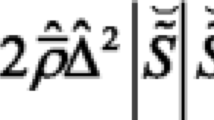Abstract
In this paper, we combine the Eulerian stochastic field (ESF) model with flamelet generated manifolds (FGM) model to achieve a new type of turbulent combustion flamelet model with high accuracy under consideration of the detailed chemical reaction mechanism. It solves the limitations of using the presumed PDF model in the original FGM model and the problems of the FGM model in the promotion of the use of non-applicability and other issues. Using OpenFOAM software and Sandia Flame D experimental data to complete the model to achieve and verify. The results show: the simulation results of the new model are good, which can accurately simulate the axial and radial temperature and the distribution of the mass fraction of the main components, and the accuracy is better than the original FGM model; with the increase of the number of stochastic fields in the ESF model, the accuracy of simulation is continuously improved; when the number of stochastic fields increases to a certain value, the simulation results are stable within a certain range of variation. The above results show that the model is effective for this type of flame simulation and has good prospects for simulating a more complex flame.





Similar content being viewed by others
References
Pope, S.B.: Small scales, many species and the manifold challenges of turbulent combustion. Proc. Combust. Inst. 34, 1–31 (2013)
Bekdemir, C., Somers, L.M.T., Goey, L.P.H.D.: Modeling diesel engine combustion using pressure dependent flamelet generated manifolds. Proc. Combust. Inst. 33, 2887–2894 (2011)
Donini, A., Bastiaans, R., Oijen, J.A.V., Goey, P.D.: Numerical simulations of a turbulent high-pressure premixed cooled jet flame with the flamelet generated manifolds technique. J. Eng. Gas Turbines Power 137, 071501 (2015)
Ma, L., Roekaerts, D.: Modeling of spray jet flame under MILD condition with non-adiabatic FGM and a new conditional droplet injection model. Combust. Flame 165, 402–423 (2016)
Bray, K.N.C., Champion, M., Libby, P.A., Swaminathan, N.: Finite rate chemistry and presumed PDF models for premixed turbulent combustion. Combust. Flame 146, 665–673 (2006)
Ge, H.W., Gutheil, E.: Simulation of a turbulent spray flame using coupled PDF gas phase and spray flamelet modeling. Combust. Flame 153, 173–185 (2008)
Ma, L., Roekaerts, D.: Numerical study of the multi-flame structure in spray combustion. Proc. Combust. Inst. 36(2), 2603–2613 (2016)
Nmira, F., Burot, D., Consalvi, J.L.: Stochastic Eulerian field method for radiative heat transfer in a propane oxygen-enhanced turbulent diffusion flame. Combust. Theor. Model. 21, 62–78 (2016)
Consalvi, J.L., Nmira, F., Burot, D.: Simulations of sooting turbulent jet flames using a hybrid flamelet/stochastic Eulerian field method. Combust. Theor. Model. 20, 1–37 (2017)
Di Renzo, M., Coclite, A., de Tullio, M.D., De Palma, P., Pascazio, G.: LES of the Sandia Flame D using an FPV combustion model. Energy Procedia 82, 402–409 (2015)
Acknowledgements
The research was founded within the Project No. 51706241 entitled: “Investigation on the mechanism of droplet/flame interaction and flamelet modeling of turbulent spray combustion” supported by the National Natural Science Foundation of China.
Author information
Authors and Affiliations
Corresponding author
Rights and permissions
About this article
Cite this article
Duan, Y., Xia, Z., Ma, L. et al. Numerical simulation of the Sandia Flame D using the ESF method coupled with FGM model. Cluster Comput 22 (Suppl 6), 15103–15110 (2019). https://doi.org/10.1007/s10586-018-2501-8
Received:
Revised:
Accepted:
Published:
Issue Date:
DOI: https://doi.org/10.1007/s10586-018-2501-8




